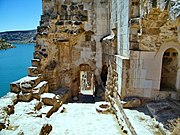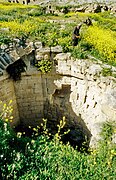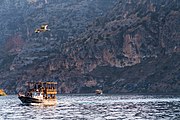Rumkale
| Rumkale | |
|---|---|
| Rumkale, Gaziantep, Turkey | |
 The Rumkale Fortress | |
| Coordinates | 37°16′19″N 37°50′17″E / 37.27194°N 37.83806°E |
| Type | Fortress |
| Site history | |
| Events | Synod of Armenian Church in 1179 |
Rumkale (lit. 'Roman Castle'; Armenian: Հռոմկլա, romanized: Hromgla[1]), also known as Urumgala,[2] is a ruined fortress on the Euphrates, located in the province of Gaziantep and 50 km west of Şanlıurfa.
History
[edit]Antiquity
[edit]Rumkale's strategic location was already known to the Assyrians, and it is possible that it was fortified by the Romans, no remains of periods earlier than 1000 CE have been identified at the site.[3] Rumkale has been suggested to correspond to Shitamrat, which was taken by Shalmaneser III (r. 859 – 824 BC) in 855 BC, due to Rumkale's location on a cliff, which is an uncommon feature among other structures in the region.[4] It is said that John, an apostle of Jesus, lived in Rumkale during Roman times.[5] Rumkale became then a part of the Byzantine Empire.
Early medieval period
[edit]From what remains of the fortress, the foundations may be traced back to the Byzantine rule. The structure was potentially guarding the Byzantine frontier and the Roman road following the right bank of the Euphrates.[6] The fortress likely evolved into a settlement in the 11th century with the immigration of Armenians from the north as the Byzantine forces displaced a significant population from their lands.[6]
By the 1080s, the region was under Philaretos Brachamios (r. 1071–1087), a Byzantine-Armenian general who carved up parts of the empire with the defeat at the Battle of Manzikert in 1071. Later, Hromgla became one of Kogh Vasil's domains, who was based in Kaysum to the north, and probably bore allegiance to Philaretos.[6][7] Kogh Vasil's adopted son Vasil Dgha was forced to hand over his lands to Baldwin II of Edessa in 1116 and it remained under the name Ranculat in Latin rule until the end of the county of Edessa.[8] With an Armenian bishop already present during that time, it was purchased by Gregory III from Beatrice of Turbessel in 1148 or 1150 to obtain a safe settlement for the Armenian Catholicosate.[9] Gregory's brother Nerses IV was elected as Armenian Catholicos here in 1166 and it seems that at this time a very considerable settlement existed there during his time that also housed representatives of the Syriac Orthodox and the Catholic Church.[10][11]

Armenian Cilician period
[edit]The castle became then part of the Armenian Kingdom of Cilicia. In the 1170 and 1172, theological conferences exploring a union of churches were held at Hromgla between the Armenian Church and the Byzantine Church with the Syrian Orthox (Jacobite) Church sending observers. In 1179, a synod of 33 Armenian bishops took place in Hromgla came up with a compromise and sent a profession of faith to Byzantine Emperor Manuel I Komnenos, but he died in September 1180 before it reached him.[12] From 1203 to 1293, it served as the residence of the Catholicos of the Armenian Church.[13] The site became an important center for manuscript production, reaching its artistic peak under the Catholicos Constantine I who employed Toros Roslin, whose stylistic and iconographic innovations had profound influence on subsequent generations of Armenian art.[11]

By 1268, Hromgla was isolated from the remainder of the Armenian kingdom of Cilicia and was attacked by a force of Mamluks of Egypt, which destroyed the town while it was unable to conquer the citadel.[14]
Mamluk period
[edit]In 1292, the castle was captured by the Mamluks following a protracted siege who then named it Qal'at al-Muslimin. The Mamluks rebuilt the castle. On several occasions, contemporary sources referred to the castle as a strategic base of the Mamluks for raids or intelligence in the lands of the Ilkhanate. It was not of the same importance as Bahasni to the north and Ayntab to the west. The castle was damaged by Timur's forces in 1400–1, but the structure was repaired again by the Mamluks.[15]
| Name | Year(s) |
|---|---|
| Kijli | 1326 |
| Anas | 1348–1349/50 |
| Sharaf al-Din Musa | 1349–? |
| Taydamur al-Isma'ili | 1350–? |
| Tuqtamur al-Kalatayi | ? |
| Aqbay al-Ashrafi | 1389 |
| Kumushbugha al-Ashrafi | ?–1392 |
| Taghanji | 1394–? |
| Tughan | ?–1413 |
| Damurdash al-Zahiri | 1413 |
| Janibak al-Hamzawi | 1414–1415/16 |
| Abu Bakr al-Babiri | ?–1417 |
| Mankli Khuja | 1417–? |
| Ayaz al-Shamsi | ? |
| Timraz al-Qirmishi | ?–1423 |
| Mughulbay al-Bajasi | ?–1452 |
| Nasir al-Din Muhammad | 1452–? |
In 1466, the Mamluk-controlled fortress fell to the Dulkadirid ruler Shah Suwar (r. 1466–72).[17] However, much of Shah Suwar's new possessions were later regained by the Mamluks, and he was caught and executed in 1472.[18]
Ottoman period
[edit]In 1516, Rumkale came under Ottoman rule following the defeat of the Mamluk Sultanate at Battle of Marj Dabiq the same year.[19] All residents of Rumkale recorded in the Ottoman defters during the 16th-century were Muslim.[20]
| Neighborhoods | |||||
|---|---|---|---|---|---|
| Year | Kazan | Qizilja | Rumlulu | Hajji Halil | Total |
| 1536 | 388 | 318 | 622 | 583 | 1911 |
| 1552 | 322 | 268 | 328 | 605 | 1523 |
| 1570 | 313 | 296 | 363 | 566 | 1538 |
| 1584 | 337 | 414 | 450 | 661 | 1862 |
| Notes | Estimates are calculated by multiplying hane (household) by 5 and adding the number of mücerreds (single people).[22] | ||||
Historian H. Basri Karadeniz identified two mosques in Rumkale, the Grand Mosque (Ulu Camii) and the Castle Mosque (Kal'a Camii) in the 16th-century Ottoman records of the town. In addition to both two mosques, historian Ali Yılmaz listed 3 mosques Horos, Mehmed Saruji, and Zeytun, as well as 4 masjids, Kubbeli, Han, Hajji Osman, and Diremli. According to Yasin Taş, these mosques were potentially located in the neighboring villages, and the town contained only the first two mosques based on the same records, which attested to the presence of a smaller clergy community in Rumkale: 1 hatib, 2 imams, 2 muezzins, and 1 duagu. In parallel, 17th-century traveler Evliya Çelebi mentioned one mosque and another in the suburbs in his seyahatnâme (travelogue).[23] The site was later repopulated by some Armenians, who were allowed to use the old catholical church.[15]
Desertion
[edit]Following the 1831 rebellion led by Bekirzade Mehmed Bey, the voivode (tax-collector, warlord) of Rumkale, the Ottoman government decreed the depopulation of the town and the destruction of the homes to prevent the fortress from harboring any future rebels.[23]

The remaining few intact buildings were bombarded by Ibrahim Pasha in 1832[15] during the Egyptian–Ottoman War, which forced the residents to relocate to the village of Kasaba, while influential families moved to the town of Halfeti on the opposite (eastern) side of the Euphrates or the city of Aintab in the west.[23]

Access
[edit]The fortress, now situated across a peninsula created by the reservoir of Birecik Dam and within the administrative boundaries of Gaziantep's Nizip district, is currently accessible by boat either from the neighboring site of Zeugma or from the town of Halfeti. As of March 2017, it was not possible to land at the site; extensive (re)building is underway inside the fortress and on the external walls.[citation needed]
Gallery
[edit]References
[edit]- ^ Sarafean, Georg Avedis (1957). A Briefer History of Aintab A Concise History of the Cultural, Religious, Educational, Political, Industrial and Commercial Life of the Armenians of Aintab. Boston: Union of the Armenians of Aintab. p. 27. Retrieved 4 September 2022.
- ^ Öcal, Mehmet; Güler, Selahaddin E.; Mızrak, Remzi (2001). Şanlıurfa kültürü sözlüğü. Şurkav Yayınları. p. 39. ISBN 9789757394235. Retrieved 18 November 2022.
- ^ Comfort, Abadie-Reynal & Ergeç 2000, p. 113.
- ^ Honigmann & Bosworth 1995, p. 606.
- ^ "Roman Castle to open to tourism". Hürriyet Daily News. Retrieved 2020-03-28.
- ^ a b c Stewart 2006, p. 269.
- ^ Dadoyan 2012, p. 41.
- ^ Stewart 2006, p. 271.
- ^ van Lint 1999, p. 32.
- ^ Russel 2005, p. 201.
- ^ a b Evans 2008, p. 141.
- ^ Hamilton 1999, pp. 4–5.
- ^ "Eastern Churches" by James Darling, London 1850, page 35, paragraph 2
- ^ Stewart 2006, p. 272.
- ^ a b c Stewart 2006, p. 270.
- ^ Stewart 2022, pp. 142–143.
- ^ Yinanç 1989, p. 65.
- ^ Yinanç 1989, pp. 74–76.
- ^ Karadeniz 1998, p. 433.
- ^ Karadeniz 1998, p. 435.
- ^ Karadeniz 1998, pp. 435–437.
- ^ Karadeniz 1998, p. 436.
- ^ a b c Taş 2024, p. 137.
Sources
[edit]- Comfort, Anthony; Abadie-Reynal, Catherine; Ergeç, Rifat (December 2000). "Crossing the Euphrates in antiquity: Zeugma seen from space". Anatolian Studies. 50: 99–126. doi:10.2307/3643016. JSTOR 3643016. Retrieved 27 February 2024.
- Dadoyan, Seta B. (1 November 2012). The Armenians in the Medieval Islamic World: Armenian Realpolitik in the Islamic World and Diverging Paradigmscase of Cilicia Eleventh to Fourteenth C. Transaction Publishers. ISBN 978-1-4128-4782-7. Retrieved 25 February 2024.
- Evans, Helen C. (2008). "Hromkla". In Evans, Helen C. (ed.). Armenia: Art, Religion, and Trade in the Middle Ages. Metropolitan Museum of Art. ISBN 9781588396600. Retrieved 27 February 2024.
- Hamilton, B. (1999). "Aimery of Limoges and the Unity of Churches". In Ciggaar, Krijna Nelly; Teule, Herman G. B. (eds.). East and West in the Crusader States: Context, Contacts, Confrontations II : Acta of the Congress Held at Hernen Castle in May 1997. Peeters Publishers. pp. 1–12. ISBN 978-90-429-0786-7. Retrieved 26 February 2024.
- Honigmann, Ernst & Bosworth, Clifford Edmund (1995). "Rūm Ḳalʿesi". In Bosworth, C. E.; van Donzel, E.; Heinrichs, W. P. & Lecomte, G. (eds.). The Encyclopaedia of Islam, Second Edition. Volume VIII: Ned–Sam. Leiden: E. J. Brill. ISBN 978-90-04-09834-3.
- Karadeniz, H. Basri (August 1998). "XVI. Yüzyılda Rumkale". Belleten. 62 (234): 425–456. doi:10.37879/belleten.1998.425. ISSN 2791-6472.
- van Lint, Theo M. (1999). "Lament on Edessa by Nerses Snorhali". In Ciggaar, Krijna Nelly; Teule, Herman G. B. (eds.). East and West in the Crusader States: Context, Contacts, Confrontations II : Acta of the Congress Held at Hernen Castle in May 1997. Peeters Publishers. pp. 29–48. ISBN 978-90-429-0786-7. Retrieved 26 February 2024.
- Russel, James R. (2005). "The Credal Poem Hawatov Xostovanim ("I confess in faith") of St. Nerses the Graceful". In Ginkel, Jan J.; Murre-van den Berg, Hendrika Lena; Lint, Theo Maarten van (eds.). Redefining Christian Identity: Cultural Interaction in the Middle East Since the Rise of Islam. Peeters Publishers. pp. 185–236. ISBN 978-90-429-1418-6. Retrieved 26 February 2024.
- Stewart, Angus (2006), 'Hromgla', in Alan V. Murray (ed.), The Crusades: An Encyclopaedia, II, p. 607. ABC-CLIO, Inc., ISBN 1-57607-862-0
- Stewart, Angus (2006). "Qal'at al Rum/Hromgla/Rumkale and the Mamluk Siege of 691 AH/1292 CE". In Kennedy, Hugh N. (ed.). Muslim Military Architecture in Greater Syria: From the Coming of Islam to the Ottoman Period. Brill. ISBN 978-90-04-14713-3. Retrieved 23 October 2024.
{{cite book}}: CS1 maint: ref duplicates default (link) - Stewart, Angus (2022). "'One Of The Most Glorious Fortresses': Rum Kale In The Sultanate Of Cairo". In Redford, Scott (ed.). Rumkale from the Medieval Period to the Present Day. Turkish Archeology and Cultural Heritage Institute. pp. 127–148. ISBN 9786257922272.
- Reuven Amitai-Preiss (1995), Mongols and Mamluks: The Mamluk-Īlkhānid War, 1260-1281, pp. 179–225. Cambridge University Press, ISBN 0-521-46226-6.
- Taş, Yasin (June 2024). "Bir Harabe Şehrin Kaybolan Mabetleri: Eski Rumkale Merkezinde Cami ve Mescitler". Journal of Waqfs (in Turkish). 61: 133–150. ISSN 2564-6796.
- Yinanç, Refet (1989). Dulkadir Beyliği (in Turkish). Ankara: Turkish Historical Society Press. ISBN 9751601711. OCLC 21676736.








